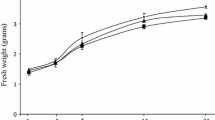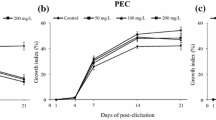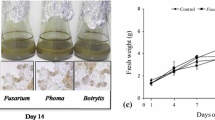Abstract
Cell suspension cultures of Linum flavum L., routinely grown on a NAA-containing medium, accumulated low levels of the phenylpropanoid-derived lignan 5-methoxypodophyllotoxin (5-MPT), up to 0.004% on a dry weight basis. Feeding experiments with the precursor L-phenylalanine resulted in a 3–5-fold increase in 5-MPT levels, but caused the levels of PAL activity to fall. Treatment of the cultures with the elicitor Nigeran, either alone or in combination with phenylalanine, caused the 5-MPT production to cease, even though PAL activity was rapidly enhanced by these treatments. Transfer of the cultures to NAA-free medium resulted in a 40–50 fold higher level of 5-MPT accumulation, the PAL activity levels being lowered compared to the routinely grown cells. With these more differentiated cultures, phenylalanine feeding and elicitor treatment, both on its own and in combination with the precursor, had no effect on 5-MPT production, even though the PAL activity levels were higher than in the untreated cells. It can be concluded that in lignan-accumulating cultures of L. flavum, PAL activity is nearly always detectable and seems to show a reciprocal relationship with 5-MPT accumulation.
Similar content being viewed by others
Abbreviations
- 5-MPT:
-
5-methoxypodophyllotoxin
- PAL:
-
phenylalanine ammonia lyase (EC 4:3:1.5)
- NAA:
-
naphthaleneacetic acid
References
Fay DA, Ziegler HW (1985) Botanical source differentiation of Podophyllum resin by HPLC. J Liq Chromatogr 8: 1501–1505
Kadkade PG (1982) Growth and podophyllotoxin production in callus tissues of Podophyllum peltatum. Plant Sci Lett 25: 107–115
Weiss SG, Tin-Wa M, Perdue Jr RE, Farnsworth NR (1975) Potential anticancer agents II: Antitumor and cytotoxic lignans from Linum album (Linaceae). J Pharm Sci 64: 95–98
Berlin J, Wray V, Mollenschott C, Sasse F (1986) Formation of β-peltatin-A-methyl ether and coniferin by root cultures of Linum flavum. J Nat Prod 49: 435–439
Berlin J, Bedorf N, Mollenschott C, Wray V, Sasse F, Höfle G (1988) On the podophyllotoxins of root cultures of Linum flavum. Planta Med 54: 204–206
Pelter A (1986) Lignans: Some properties and syntheses. Rec Adv Phytochem 20: 201–241
Jackson DE, Dewick PM (1984) Biosynthesis of Podophyllum lignans-I. Cinnamic acid precursors of podophyllotoxin in Podophyllum hexandrum. Phytochemistry 23: 1029–1035
Holthuis JJM (1988) Etoposide and teniposide. Bioanalysis, metabolism and clinical pharmokinetics. Pharm Weekbl (Sci) 10: 101–116
Richter A, Strausfeld U, Knippers R (1987) Effects of VM-26 (teniposide), a specific inhibitor of type II DNA topoisomerase on SV40 DNA replication in vivo. Nucleic Acids Res 15: 3455–3468
Beers SA, Imakura Y, Dai HJ, Li DH, Cheng YC, Lee KH (1988) Antitumor agents. 99. Synthetic ring C aromatized podophyllotoxin analogues as potential inhibitors of human DNA topoisomerase II. J Nat Prod 51: 901–905
Inamori Y, Kubo M, Tsujibo H, Ogawa M, Baba K, Kozawa M, Fujita E (1986) The biological activities of podophyllotoxin compounds. Chem Pharm Bull 34: 3928–3932
Bedows E, Hatfield GM (1982) An investigation of the antiviral activity of Podophyllum peltatum. J Nat Prod 45: 725–729
Ebel J (1986) Phytoalexin synthesis: the biochemical analysis of the induction process. Ann Rev Phytopathol 24: 235–264
Dixon RA (1986) The phytoalexin response: elicitation, signalling and control of host gene expression. Biol Rev 61: 239–291
DiCosmo F, Misawa M (1985) Eliciting secondary metabolism in plant cell cultures. Trends in Biotechnol 3: 318–322
Imoto S, Ohta Y (1988) Elicitation of diacetylenic compounds in suspension cultured cells of eggplant. Plant Physiol 86: 176–181
Funk C, Gügler K, Brodelius P (1987) Increased secondary product formation in plant cell suspension cultures after treatment with a yeast carbohydrate preparation (elicitor). Phytochemistry 26: 401–405
Dixon RA, Lamb CJ (1979) Stimulation of de novo synthesis of L-phenylalanine ammonia lyase in relation to phytoalexin accumulation in Colletotrichum lindemuthianum elicitor-treated cell suspension cultures of french bean (Phaseolus vulgaris). Biochim Biophys Acta 586: 453–463
Gerrish C, Robbins MP, Dixon RA (1985) Trans-cinnamic acid as a modulator of chalcone isomerase in bean cell suspension cultures. Plant Sci 38: 23–27
Rolfs CH, Schön H, Steffens M, Kindl H (1987) Cell suspension culture of Arachis hypogaea L: model system of specific enzyme induction in secondary metabolism. Planta 172: 238–244
Tietjen KG, Matern U (1983) Differential response of cultured parsley cells to elicitors from two non-pathogenic strains of fungi. Eur J Biochem 131: 409–413
Berlin J (1988) Formation of secondary metabolites in cultured plant cells and its impact on pharmacy. In: Bajaj YPS (Ed) Biotechnology in Agriculture and Forestry 4. Medicinal and Aromatic Plants I (pp 37–59) SpringerVerlag, Berlin/Heidelberg
Knobloch KH, Berlin J (1980) Influence of the medium composition on the formation of secondary compounds in cell suspension cultures of Catharanthus roseus. Z Naturforsch 35: 551–556
Kurz WGW, Constabel F (1985) Aspects affecting biosynthesis and biotransformation of secondary metabolites in plant cell cultures. Crit Rev Biotechnol 2: 105–118
Misawa M (1985) Production of useful plant metabolites. Adv Biochem Eng 31: 59–88
Murashige T, Skoog F (1962) A revised medium for rapid growth and bioassay with tobacco tissue cultures. Physiol Plant 15: 473–497
Gamborg OL, Miller RA, Ojima V (1968) Nutrient requirements of suspension cultures of soybean root cells. Exp Cell Res 50: 151–158
Lim CK, Ayres DC (1983) High-performance liquid chromatography of aryltetrahydronaphthalene lignans. J Chromatogr 255: 247–254
van Uden W, Pras N, Visser JF, Malingré Th M (1989) Detection and identification of podophyllotoxin produced by cell cultures derived from Podophyllum hexandrum Royle. Plant Cell Rep 8: 165–168
Zucker M (1965) Induction of phenylalanine deaminase by light and its relation to chlorogenic acid synthesis in potato tuber tissue. Plant Physiol 40: 779–784
Bradford MM (1976) A rapid and sensitive method for the quantitation of microgram quantities of protein utilizing the principle of protein-dye binding. Anal Biochem 72: 248–254
Schumacher HM, Gundlach H, Fiedler F, Zenk MH (1987) Elicitation of benzophenanthridine alkaloid synthesis in Escholtzia cell cultures. Plant Cell Rep 6: 410–413
Ayres DC (1969) Incorporation of L-[U-14C]-β-phenylalanine into the lignan podophyllotoxin. Tetrahedron Lett 11: 883–886
Ayres DC, Farrow A, Carpenter BG (1981) Lignans and related phenols. Part 16. The biosynthesis of podophyl-lotoxin. J Chem Soc Perkin Trans 1: 2124–2136
Tietjen KG, Hunkler D, Matern U (1983) Differential response of cultured parsley cells to elicitors from two non-pathogenic strains of fungi. Eur J Biochem 131: 401–407
Chappell JC, Nable R (1987) Induction of sesquiterpenoid biosynthesis in tobacco cell suspension cultures by fungal elicitor. Plant Physiol 85: 469–473
Margna U (1977) Control at the level of substrate supply — an alternative in the regulation of phenylpropanoid accumulation in plant cells. Phytochemistry 16: 419–426
Camm EL, Towers GHN (1973) Phenylalanine ammonialyase. Phytochemistry 12: 961–973
Author information
Authors and Affiliations
Rights and permissions
About this article
Cite this article
van Uden, W., Pras, N., Vossebeld, E.M. et al. Production of 5-methoxypodophyllotoxin in cell suspension cultures of Linum flavum L.. Plant Cell Tiss Organ Cult 20, 81–87 (1990). https://doi.org/10.1007/BF00114704
Accepted:
Issue Date:
DOI: https://doi.org/10.1007/BF00114704




